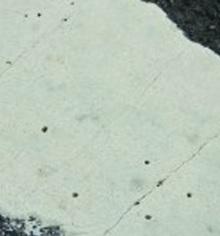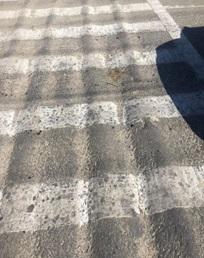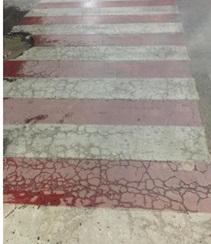| DATE: DECEMBER 2022 |
|
|
|
|
| PREPARED BY: BALWINDER SINGH, ASST. BUSINESS MANAGER KATALINE INFRAPRODUCTS PVT. LTD. |
|
|
|
|
| LOCATION: MULTIPLE LOCATIONS - NORTH INDIA |
|
|
|
|
| OBSERVATION: |
|
|
|
|
|
|
|
|
|
| Image |
Problem and Observation |
Causes |
Preventive Measures |
Remarks |
|
Pinholes |
|
|
|
 |
Small holes observed on the surface of thermoplastic line marking after application |
Evaporation and expansion of the moisture on surface |
Do not apply thermoplastic immediately after rain or under Dew conditions. |
|
|
|
|
Allow time for road surface to dry completely. |
|
|
|
|
Allow for proper curing of concrete surface |
|
|
|
|
Ensure marking is done after a minimum 75 days of finish coat of Bitumen / Concrete surface |
|
|
|
|
Let primer dry completely before application. |
|
|
|
|
Gradually increase the temperature of thermoplastic and avoid over heating |
|
|
|
|
|
|
|
Blackening of Road Marking |
|
|
|
 |
Surface of thermoplastic line marking becomes black |
Vehicles tyres transfer dust and carbon deposited on the tyre surface onto fresh marking |
Allow for Bitumen to cure for minimum 75 - 90 days before application of thermoplastic road marking |
Generally temporary blackening on account of Carbon / dust can be washed with Potable water. |
|
|
Vehicle tyres transfer freshly laid Bitumen on to the surface |
Allow vehicles to transverse on road after minimum 2 hrs / required curing time of thermoplastic |
Also check for surface conditions. Certain areas such as speed breakers, petrol pump entrances, parking area entrances are prone to erratic vehicular traffic and braking causing excessive wear and tear of thermoplastic along with blackening. |
|
|
Bleeding of Bitumen due to insufficent curing |
|
|
|
|
|
|
|
|
Cracks |
|
|
|
 |
Cracks on the surface of road marking |
Thermoplastic is too hard or does not exhibit expansion and contraction under natural weather conditions |
Cold season with big variation of the temperature between the day and night contributes more to this problem. |
Thermoplastic road marking over 2 Component cold plastic road marking should be avoided or vice-versa |
|
|
Uneven thickness leading to different hardening speed of the thermoplastic. |
Adjust the laying shoe of the applicator. |
For coloured road surfacing, 2 component cold plastic provides better durability than thermoplastic |
|
|
Improper surface conditions |
Always ensure proper curing of concrete or asphalt surface has been done |
|
|
|
|
Remove the existing road marking prior to application of new road marking |
|




